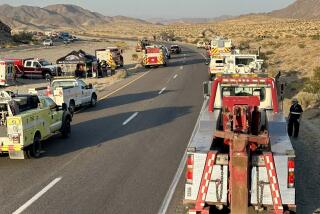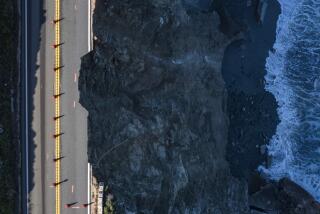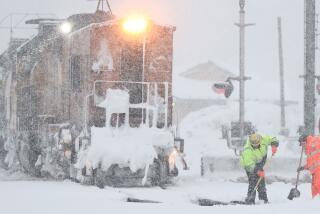Big Rigs’ Return Fuels a Recovery in Castaic : Economy: Easier travel for truckers along Interstate 5 is good news for a town dependent on them.
- Share via
If anyone was skeptical that truckers are the lifeblood of Castaic, that doubt has gone the way of cheap diesel fuel and mirrored sunglasses.
After the collapse of a freeway overpass during the Northridge earthquake, the major north-south route of Interstate 5 was closed to trucks for two weeks, crippling this town of 13,000 about 40 miles north of Los Angeles.
Usually bustling restaurants closed or cut back staff to a handful of employees. The local bar depended on locals for a change. The Giant Truck Stop, which usually fuels hundreds of big rigs daily, saw its business running on empty.
“We were in a world of hurt,” said John Dunne, manager of the truck stop famous among drivers from San Diego to Seattle, and where a sign reminds all that “Fueling Truckers Shower First.”
“Beginning about 4:35 a.m. the day of the quake, business dropped by about 80%--and it stayed that way for the better part of two weeks,” Dunne said.
Things were not much better a few blocks down the street in a restaurant where hungry drivers are accustomed to devouring road fare favorites such as the beefy bean burrito.
“This place was just dead,” said Nicole Davis, who had been laid off as a cashier at Cafe Mike for a week during the closure. “But every day, it’s getting a little better.”
Turning to one trucker as she punched his dinner tab on the antiquated cash register and handed him his change, Davis said: “If it wasn’t for you guys, this town would be a ghost town.”
As more roads reopen, the truckers are slowly coming back. But there are still rough spots. Only two northbound lanes of the I-5 are open for trucks. Caltrans and the California Highway Patrol are still advising truckers to avoid the road and have issued a list of alternates.
“It’s been tough to get over here since the quake . . . too much traffic and all,” said Turloch produce hauler Gene Lee, digging into a hefty platter of rice and beans. “But this has been a hangout of mine for 27 years. I’m not about to give it up.”
Waitress Kim Cimino said although she was relieved to see Lee and other truckers return, things were not back to normal.
“I usually write 100 (food) checks a nights,” she said thumbing through the scant stack she had accumulated. “Tonight I’ll write 60 . . . maybe.”
Business this week at the truck stop was back to about 80% of pre-quake levels, Dunne said. He added that two of his 30 employees had quit to look for other work because they could not survive on the 20-hour workweek offered during the closure.
He said business bounced back so quickly thanks largely to a loyal clientele, such as Dennis Kates, who had stopped to refuel his rig while hauling a load of telephone poles from Portland to Long Beach.
“I usually run straight up 5,” the lanky trucker said, as two men in overalls washed the windshield of his 18-wheeler. “I’ve been coming here twice a week for the past two or three years.”
Across the street at the Country Girl bar, sales were also approaching normal for the first time since the temblor, said bartender Brenda Galusha.
“We’re at about 75% or so,” Galusha said, passing a frosty bottle of beer over the bar. “But if they would have kept this freeway closed for six months . . . this place would have gone out of business.”
One aspect of the Castaic economy that was not hammered by the quake was the hotel industry.
“The whole town is booked. We haven’t had a room since the day of the quake,” said Kim Csernay, general manager of the Comfort Inn, which has become home to quake victims and relief workers.
Csernay said occupancy this time of year normally runs about 70%.
“We’re not taking any reservations for the month of February and we’re turning away at least 50 people a day,” she said. “I’d like to be this busy under different circumstances.”
More to Read
Sign up for Essential California
The most important California stories and recommendations in your inbox every morning.
You may occasionally receive promotional content from the Los Angeles Times.














